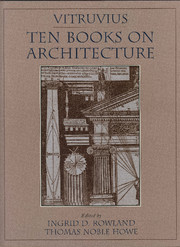Book contents
- Frontmatter
- Dedication
- Contents
- Acknowledgments
- List of Illustrations
- Translator's Preface
- Illustrator's Preface
- VITRUVIUS
- INTRODUCTION
- LIST OF MANUSCRIPTS SEEN
- THE TRANSLATION
- Book 1 First Principles and the Layout of Cities
- Book 2 Building Materials
- Book 3 Temples
- Book 4 Corinthian, Doric, and Tuscan Temples
- Book 5 Public Buildings
- Book 6 Private Buildings
- Book 7 Finishing
- Book 8 Water
- Book 9 Sundials and Clocks
- Book 10 Machines
- COMMENTARY
- Index
Book 2 - Building Materials
Published online by Cambridge University Press: 18 December 2014
- Frontmatter
- Dedication
- Contents
- Acknowledgments
- List of Illustrations
- Translator's Preface
- Illustrator's Preface
- VITRUVIUS
- INTRODUCTION
- LIST OF MANUSCRIPTS SEEN
- THE TRANSLATION
- Book 1 First Principles and the Layout of Cities
- Book 2 Building Materials
- Book 3 Temples
- Book 4 Corinthian, Doric, and Tuscan Temples
- Book 5 Public Buildings
- Book 6 Private Buildings
- Book 7 Finishing
- Book 8 Water
- Book 9 Sundials and Clocks
- Book 10 Machines
- COMMENTARY
- Index
Summary
PREFACE
1. Dinocrates the architect,* full of confidence in his ideas and his cleverness, set out from Macedonia for the army in the days of Alexander's rise to power, ambitious for royal favor. From home he carried letters of recommendation from neighbors and friends, addressed to the king's generals and highest court officials, in order to facilitate his access to them; when these generals received him, he asked them courteously to present him to Alexander as soon as possible. Despite their promises, they were slow to do so, waiting for some suitable occasion. And thus Dinocrates, supposing that they were playing games with him, sought help in his own resources. He was a very tall man, handsome, with a fine face and immense dignity. Trusting, then, in those gifts of Nature, he went back to his inn, undressed, and thoroughly oiled his body. Crowning his head with a poplar wreath, draping his left shoulder in a lion skin and brandishing a club in his right hand, he strode before the tribunal where the king was hearing petitions. 2. When the crowd began to take notice of this novelty, Alexander, too, looked Dinocrates's way. Impressed by the young man, the king ordered the crowd to make way for him to approach the tribunal, and asked who he was.
“Dinocrates,” he answered, “an architect of Macedon, who brings you ideas and plans worthy of your renown. I have, for example, a project to carve all Mount Athos into the image of a man. In his left hand I have represented the walls of a spacious city; in his right, a libation bowl where the waters of all the rivers that run on that mountain will gather together and plunge into the sea” (Figure 28).
3. Alexander, delighted with the idea, inquired immediately about the nature of the plan – were there farmlands to furnish this city with a regular supply of grain?
- Type
- Chapter
- Information
- Vitruvius: 'Ten Books on Architecture' , pp. 33 - 45Publisher: Cambridge University PressPrint publication year: 1999



